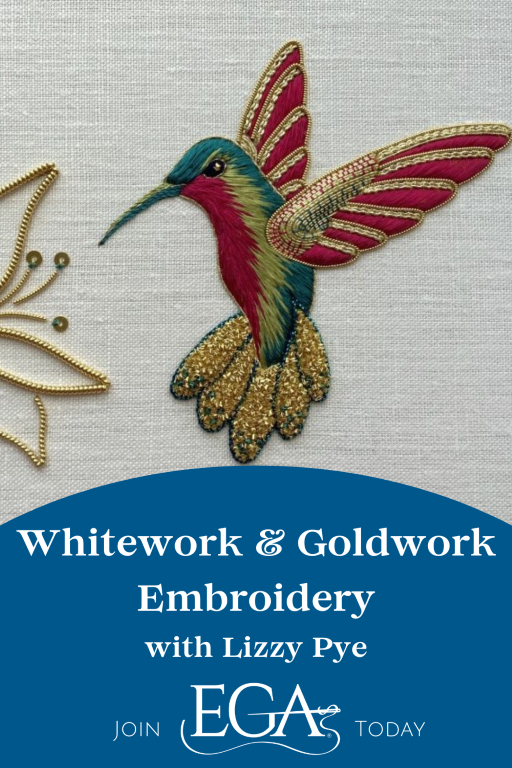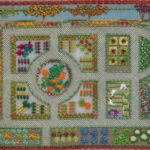This month we sat down with Lizzy Pye, an embroidery tutor classically trained in the Royal School of Needlework Apprenticeship, and a past and present teacher of some of EGA’s most popular classes. Lizzy provided some insight into her love of needlework, including why she feels drawn to detail work, how she begins to create one of her intricate designs, and what she has planned for future embroidery projects. Lizzy’s upcoming Online Studio Class, Hummingbird in Silk & Gold, explores a range of traditional goldwork techniques as well as silk shading to achieve the hummingbird’s prismatic colors.
On your website, you write: “I love all embroidery techniques and struggle to choose a favourite, but I am always most drawn to detailed work.” Why are you most drawn to detailed work?
This is a funny question for me. It sparks so much. I’ve always flitted from one craft/art form to another, and I’ve always been detail focused. It’s part of my nature; I’ve been this way since birth. I’ve recently realized I’m Autistic and I have ADHD—so really, those are the reasons!
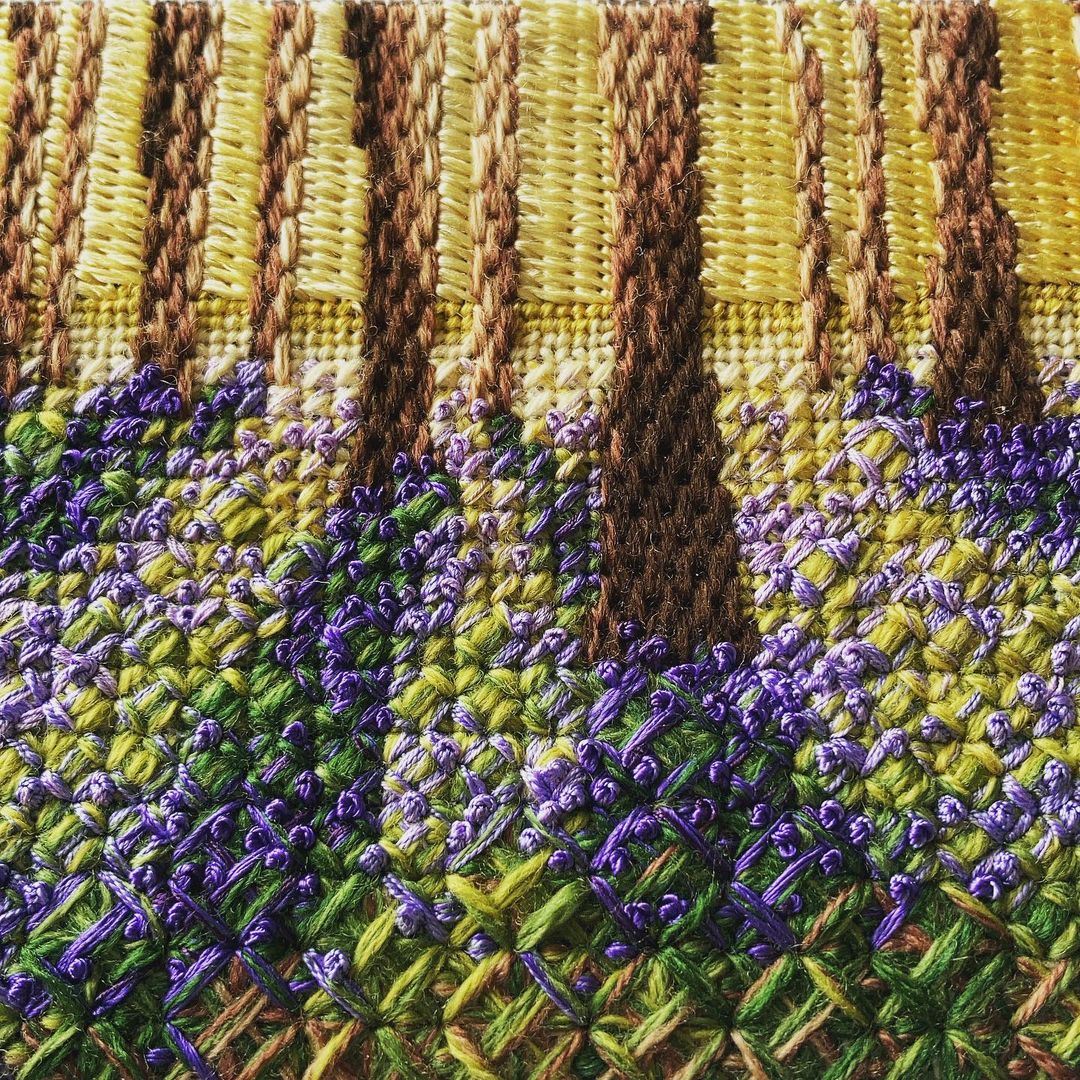
ADHDers tend to get bored easily—this is so me. Embroidery really caters to this: under the umbrella of “embroidery” I can flit from whitework to goldwork and one style to another. It keeps my brain happy. I love detail because it’s always a challenge. I love a challenge, a problem to solve, more than anything else. I’m very lucky that my fine motor skills are really good, because focusing on details in all aspects of my life means I fall over a lot!
I think detail also feeds my brain because when I look at embroidery, whether it be a historical piece in a museum or a newly created design on Instagram, I’m instantly pouring over the details. It takes me a long time to see the wood for the trees!
I have a new found love for Jacobean now that I incorporate a lot more interesting stitch combinations. This is my latest Jacobean class piece, in which I’m using much more detailed stitching than I did when I was training.
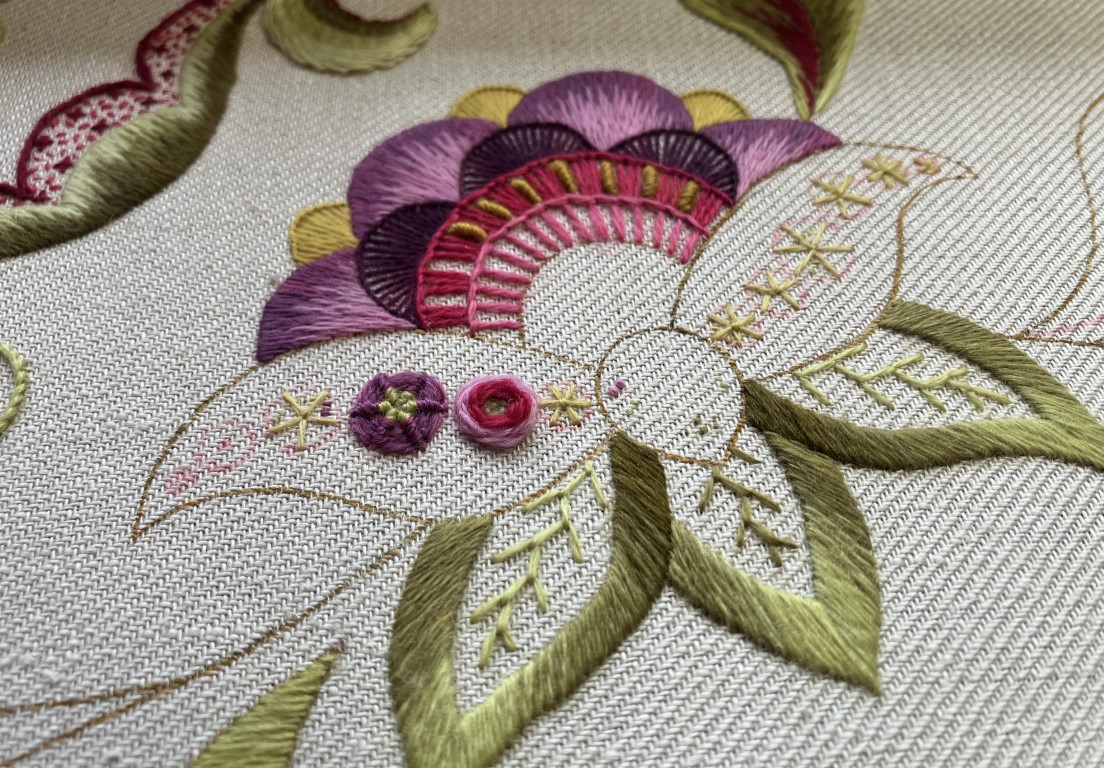
You are a classically trained needleworker, having been an Apprentice at the Royal School of Needlework Apprenticeship 2006-2009. Knowing that you were among the last graduating class of RSN Apprentices and that the program has since changed, what was that experience like? Did you have a particular focus?
Being one of the last was definitely a strange experience. Of course, we joined expecting there would be another cohort coming along behind us. I feel very fortunate and grateful to have studied in the way I did. The hours upon hours of stitching are incomparable to anything else. I remember getting up at 4:30am and stitching before going to the RSN for the day’s tuition, then getting home and starting all over again after a quick bite to eat; frequently finishing for the day around 10pm.
It was hard being an Apprentice, but I loved those years. It was truly immersive like nothing else could really be, which suited me perfectly.
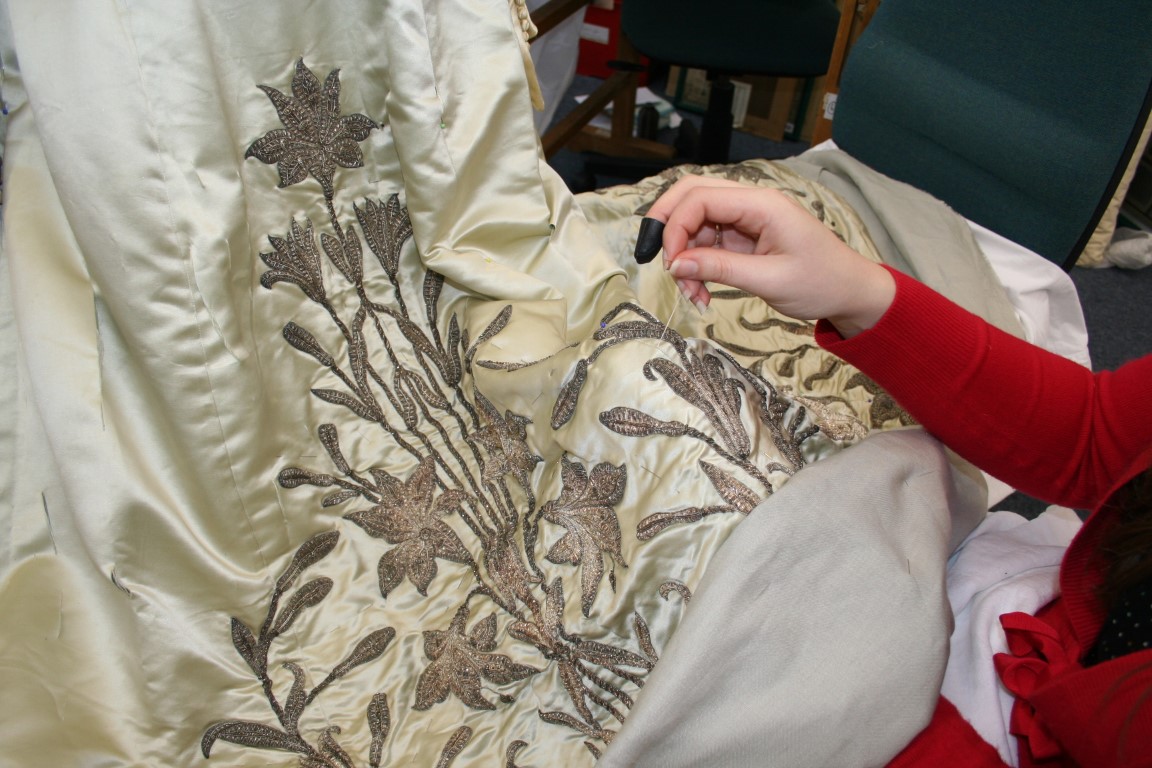
Your previous class at EGA, Cunning Fox, aimed to enhance student’s Whitework skills. You’ve also written the RSN Essential Stitch Guide: Whitework. What draws you to Whitework? What should students new to the technique know about Whitework before starting a project?
I think the aspect that draws me most to Whitework is that it looks so simple, and yet that belies its true nature. White on white, using just shadow and highlight to create a design, is a challenge like no other. I also love the traditions behind it. That Whitework is an embroidery technique that has mostly been stitched by women (for home linens, dowry pieces, Christening robes and so on), is somehow very appealing to me.
It is such a rich umbrella of a technique. There are styles of whitework I haven’t had the chance to try yet, and that’s exciting! My training was in a set of classical techniques, which then allowed me to create what the Royal School of Needlework call “Fine Whitework”. It is loosely based in Ayrshire whitework, worked on very fine linen with net inclusions and lots of different stitches. I found the process of designing and working it absolutely fascinating, and I still love designing whitework today.
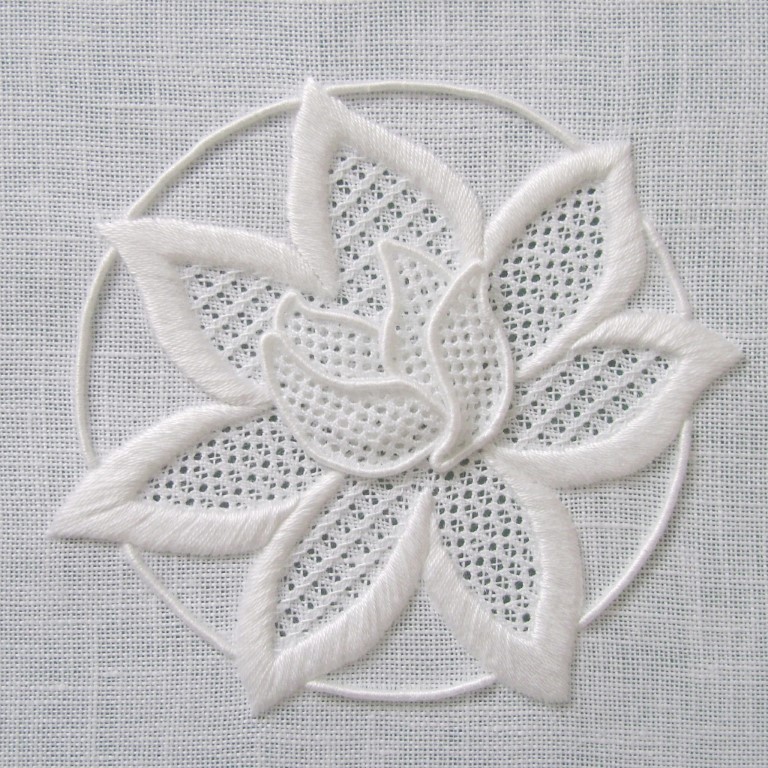
Hummingbird in Silk & Gold incorporates several metal thread work techniques, such as couching threads, couching pearl purl, chipping, and felt padding, combined with satin and stem stitch in colored threads and silk shading to create contrast and depth. How do you approach the process of combining techniques to create new designs?
This is a tricky question. It’s almost like my brain thinks in stitches, so in one way it isn’t really a process, it just happens.
That said, I can break it down a bit. I often think of colour first, and then technique. So with the hummingbird I was just looking at colourful things, including real hummingbirds, and picked my three favourites—luckily they look pretty stunning together! I did take some time to choose the exact shade of each to get a nice look.
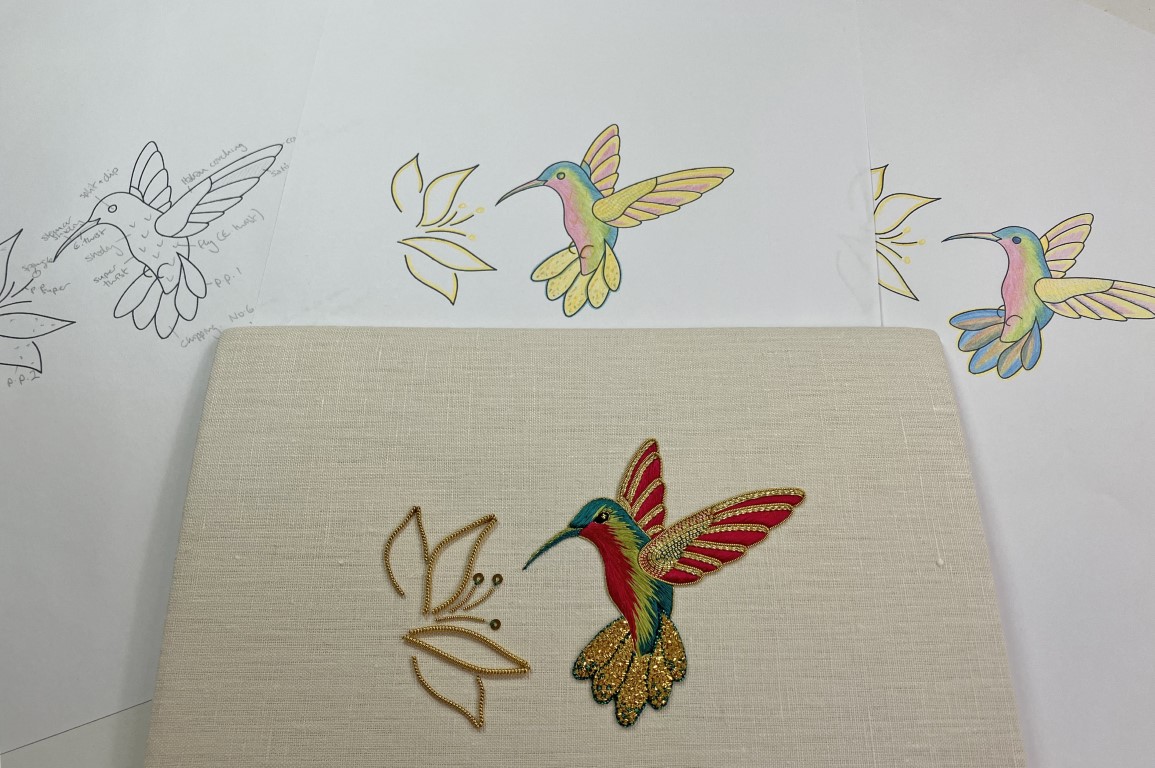
I knew I wanted to do a bit of goldwork, but I wasn’t initially sure how much. I created the outlines and then doodled with colour pencils until I got close to what I wanted. Then I thought about how I could use padding to create some extra dimension.
When I’m designing something to teach, I always have the student experience in the back of my mind. So, for example, I considered whether I should add cutwork to the hummingbird. In the end I decided against it because I wanted the silk to really sing, and cutwork would have needed a bigger space and therefore dominated the design. I might have put it in the tail, but having lots of cutwork in adjacent areas is very difficult until you’re an advanced goldworker, so I didn’t go very far down that road.
I’m working on a design right now that will possibly be whitework and goldwork combined. This is a new one for me, so it’s an exciting prospect. I’m working on the same principles. I will draw out the shades and tones of the whitework, and add gold details where they enhance the design. Most likely I will have a few tries until I settle on something that really speaks to me.
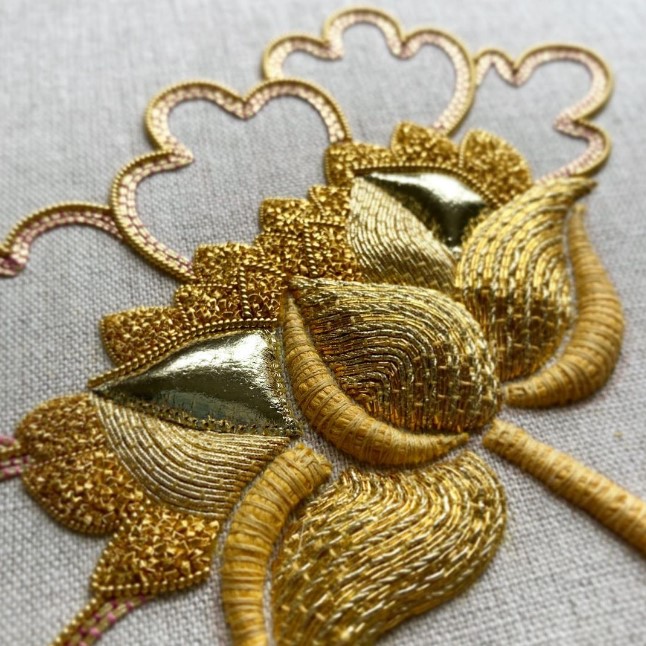
What are your favorite, must-have tools for goldwork?
I have to admit, I don’t use a lot of tools for goldwork. I am pretty picky about my scissors, but I don’t use the special “goldwork scissors” with serrated blades. My favourites are Fiskars Classic Embroidery and Janome Fine Tip—both are very narrow in the blade, which is the top criteria in my book. They are also very easy to sharpen at home, which is a huge advantage. I ALWAYS use a separate pair of scissors for metal threads, and I tie a bit of scrap metal thread onto them so I can spot them easily in my needlework box.
I’m very lucky that my skin is so dry and it has a fairly neutral pH, so I don’t tend to get in trouble handling the metal threads. I know plenty of people for whom this is not the case, and for anyone who has issues, I suggest having a mellor and round ended tweezers. A mellor is amazing for the jobs that I would use a fingernail for—poking gold into place, smoothing edges, that sort of thing. Round ended tweezers allow you to pick up and move the gold without damaging it.

When I’m finishing metal threads, I have a couple of go-to helpers: Clover flexible rubber thimbles, or needle grabbers. Both of these give a lot of extra grip for plunging the threads to the back, and also really help me hold onto the curved needle without excessive strain on my fingers (I’m hyper mobile which makes me prone to pain from that sort of strain, so this is extra important for me).
Do you have a daily/weekly practice that you’d recommend to other embroiderers interested in honing their craft?
I think this is like anything in life. To improve, you must first do it badly. Practising any type of embroidery regularly, will improve your skill across the board. Funnily enough, I was having this conversation with the ladies who have been doing Jacobean and Silk Shading with me monthly for a year. The resounding verdict was that their skills have improved so much that when they look at previous embroidery or fancy taking on a new project, they have a whole new appreciation for their well-honed skills.
I also feel very strongly that we never stop learning. Life is about learning, and embroidery is no different. I learn something with every class I teach: I joke that in some classes I learn more than my students! While this may not be objectively true, I really do feel like practice and communication with others in the craft is so helpful.

I also strongly believe in working on what inspires you. I can’t function any other way! So, if I don’t feel like stitching, I don’t stitch. Instead I might paint miniatures, draw, knit or crochet. All these things keep up my skills – dexterity, coordination, my eye for colour, etc.
It’s so easy these days to get sucked into “doom scrolling” so instead I try to inspo-scroll—I immerse myself in inspirational images, stories or history. I try not to beat myself up if I’m not engaging in something “productive” even though my perfectionist streak finds that really hard!
Do you have any advice for needleworkers approaching metal thread work for the first time?
Buy a new pair of scissors (remember: narrow blades), you won’t regret it.
Cut your metal threads longer than you think to begin with. Plunging takes practice! I might get away with less than an inch of excess, but on a first try I would allow at least an inch and a half so you can manipulate it easily.
Stitch at a higher tension than you might expect. I never have this problem; I’m constantly complaining about my ridiculously tight stitching tension. But for those who have a lighter touch naturally, or are used to reining it in a bit—pull tighter.
Along the same lines; a drum tight frame is absolutely essential. It is SO much easier to work on a frame that isn’t bouncing all over the place.
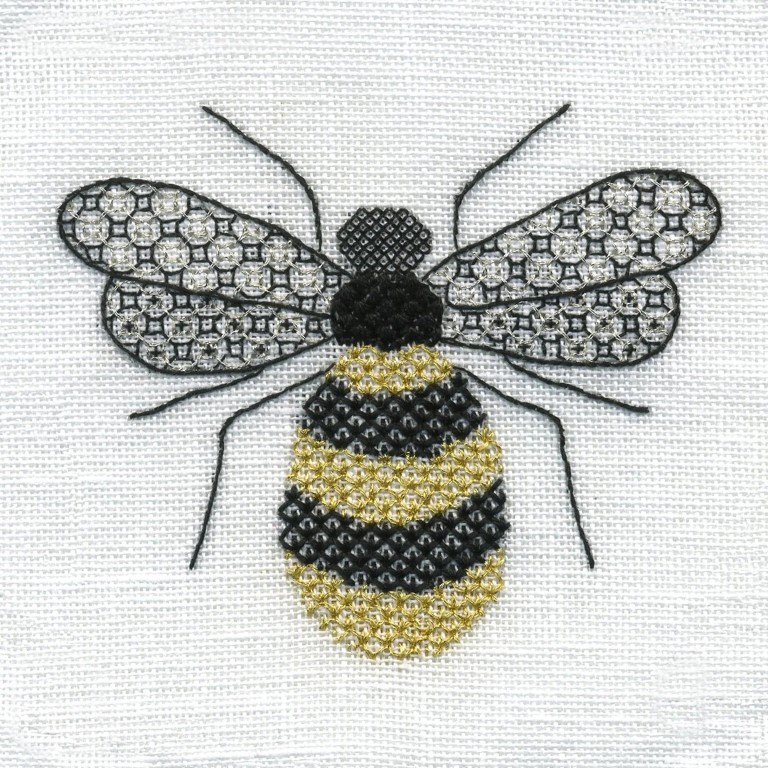
What embroidery or color trends (if any) are you drawn to right now?
I’m really bad at trends. I don’t look ahead at forecasts or anything like that; I find the idea very overwhelming! I stitch whatever I feel is right at the time. Right now, whitework is calling me again, so I’m working on a design loosely based on the Japanese Garden I stitched during my Apprenticeship (those familiar with my whitework book will have seen it before). I also have in my head the idea of a winter twin for the hummingbird, but I know I don’t have time to stitch it yet. Ideas often mull in my head until I have the time to dedicate to them, or a flash of inspiration takes me. I’m sure I’m not the only crafter who has more ideas than time to make them!
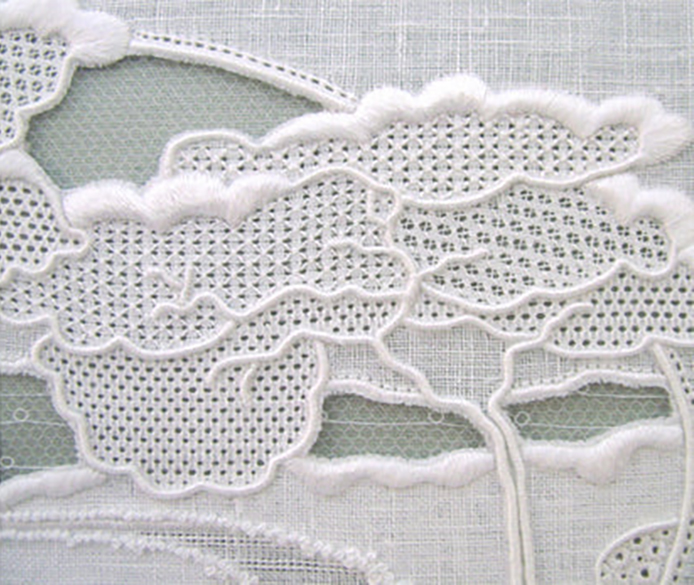
What do you hope embroiderers take from your class, Hummingbird in Silk & Gold?
I always hope that everyone learns something. Even if it is one simple thing. But my main hope is that embroiderers will find joy in it. What is life, without the simple pleasure of needle and thread? That’s joy for me, and I want to share it.
Thank you to Lizzy Pye for illuminating EGA’s readers on her process. Interested in taking Lizzy’s upcoming class, Hummingbird in Silk & Gold? Register here!
Like this post? Pin it!
